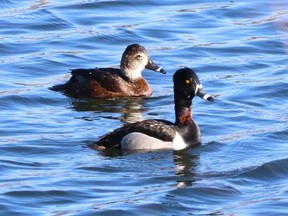This week's collection of Sightings

Article content
Richard’s photo of the male ring-necked duck, the bird in the foreground, clearly shows the obscure rich brown “ring” that encircles the base of the neck and gives this duck its name. But most of the time this feature is very hard to see. If the bird was being named today I expect it might be called the “ring-billed” duck because of the conspicuous white ring found on the beak of both sexes. We can see that white ring clearly in Richard’s image. Jim

We don’t get many porcupines submitted to Sightings, so this young animal gives us a good opportunity to take a close look. As most know, the porcupine is a rodent and eats plant material year-round, including the bark of living trees. I understand there is only one species of porcupine here in North America, but worldwide there are about 30. Steven submitted two photos, but unfortunately we have space for only one so I chose the one showing the animal’s face. The other image was of the porcupine’s back and tail, which are loaded with hundreds of sharp quills that come loose easily if the porcupine strikes another animal with its tail or is bitten on its body by a predator. Although easily transferred by contact, the quills have tiny barbs on their tip that make them hard to remove from the unfortunate recipient. Jim

Everyone remembers their first cardinal, usually quite vividly if the bird was a male. But female cardinals are quite beautiful too. There is no question that the main hotspot for cardinals in N.B. for the past two decades has been the Kennebecasis Valley in the south from Saint John to Sussex, but cardinals have continued to expand north and eastward and are now seen much more frequently in Moncton and other areas in central and even northern N.B. Hopefully this pair will nest somewhere near John and Rolene’s property this spring or summer. Jim

Denise’s female downy woodpecker has her head and neck feathers raised because of what I assume is excitement. April certainly is the time that we have noticed both our downy and our hairy woodpeckers interacting excitedly when together at the feeders, with the hairy woodpeckers starting a bit earlier in the spring than the downies. Those interactions should soon lead to pair bonding and then the excavation of a nest cavity in a dead or dying tree and the laying of a clutch of four or five pure white eggs. It’s interesting that most nest cavities of downy woodpeckers I’ve seen have been in dead wood while those of the larger hairy woodpecker have been in live trees, often white birch. Jim

By looking at Heather’s photo we can certainly see why the red-winged blackbird is appropriately named. In spring the red epaulettes (shoulders) of the male are a rich orange-red and the birds frequently show off those colours to attract and impress potential mates in freshwater marshes where the blackbirds gather to nest in loose colonies. As soon as the ice melts out and the males return from the south they gather in wetlands and the spring breeding ritual begins, which includes a variety of posturing and vocalizations designed to win the hearts of the ladies who arrive a week or two later. Jim

Margaret’s song sparrow from two years ago appears to have returned to her property again this year, something that many songbirds will do if they survive their southward migration. The reason songbirds like this song sparrow peck and flutter at house windows is that they’re seeing their own reflection in the glass (like in a mirror) and they want to drive the “competitor” away. Because the competitor keeps appearing each time the sparrow checks for it, the scenario plays out day after day until the nesting season is over much later in the summer. The only way to prevent the bird from doing that is to cover the reflective outside surface of the window with something that will break up the reflection. Jim

Leucistic birds like this one certainly catch your eye and sometimes it can be a puzzle to figure out just what it is. But Denise’s junco has enough normal features for her to be sure of what she was looking at. Apparently leucism (a lack of normal pigmentation in parts of a bird’s plumage or a mammal’s pelage at birth) is most often noted in species that normally have black or dark pigmentation. This is why crows and grackles are sometimes reported with white markings in their plumage, although I understand leucism can occur in any animal, regardless of normal colouration. Jim

Here is a second leucistic bird just this week, this time not a bird that is normally black. Amy’s robin is lacking only some of its normal pigmentation, but not all of it, so it’s a leucistic bird. An albino creature lacks all of its normal pigments, including in its un-feathered “soft” parts (eyes, legs, feet). An albino is totally white with most soft parts appearing pinkish because of the blood supply. In true albinos I understand that the animal usually has poor eyesight for want of normal eye pigmentation. Jim
JIM WILSON is the chair of the New Brunswick Bird Records Committee. Send your Sightings of live animals and birds by email to tjsightings@postmedia.com. Please indicate your full name and the community where you live. Due to space constraints, we are not able to publish all the submissions we receive.












Postmedia is committed to maintaining a lively but civil forum for discussion. Please keep comments relevant and respectful. Comments may take up to an hour to appear on the site. You will receive an email if there is a reply to your comment, an update to a thread you follow or if a user you follow comments. Visit our Community Guidelines for more information.